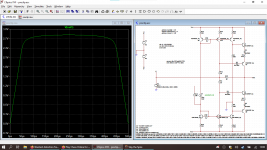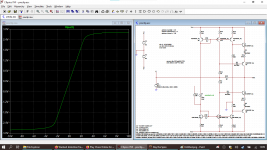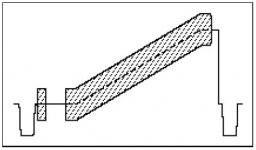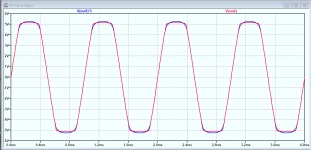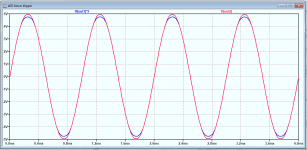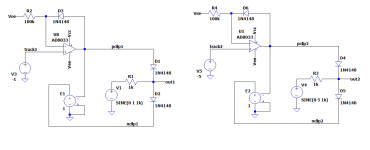Mark, which windows player supports these plugins? I'm currently using foobar..
One paid app that supports VST3 plugins: https://audirvana.com/
A free app: http://www.beladaddy.com/VST-host.HTML
Looks like there is a VST host plugin for the MusicBee player: https://getmusicbee.com/addons/plugins/16/vst-effects-support/
In terms of doing it for free, IIUC there are some freeware standalone VST hosts, for example: https://hiphopmakers.com/best-free-vst-host-applications
With one of those and a virtual audio cable to route the audio stream from you player app to the VST host and then from there out to your dac, maybe something like: https://vb-audio.com/Cable/index.htm
"VST pluginsfor free, IIUC there are some freeware standalone VST hosts
"Audacity can load VST effects (but not VST instruments) on all operating systems"
https://plugins.audacityteam.org/
I don't think that supports streaming, but is a fine platform for many things.
Boards arrived, parts arrived, assembled and first scope waveforms.Wow! Amazing productivity! 👍
1KHz sine no clip, hard clipped followed by changing softness pot with
no change on clip level. It's behaving just as predicted.
THD measurements to follow.
Signals from Adobe Audition 3 and yeah, I see the quirks near the
extremes. I'll check it with a Heathkit sine generator.
G²
Attachments
-
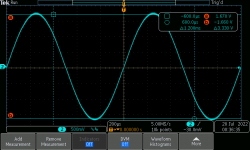 tek00004.png30.1 KB · Views: 117
tek00004.png30.1 KB · Views: 117 -
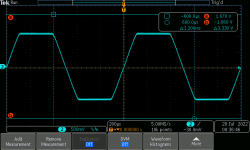 tek00005.png27.6 KB · Views: 124
tek00005.png27.6 KB · Views: 124 -
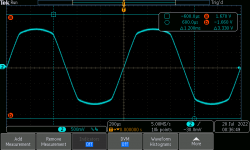 tek00006.png28.4 KB · Views: 118
tek00006.png28.4 KB · Views: 118 -
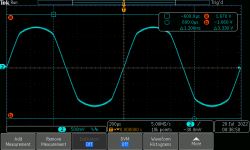 tek00007.png28.4 KB · Views: 123
tek00007.png28.4 KB · Views: 123 -
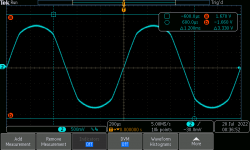 tek00008.png12 KB · Views: 121
tek00008.png12 KB · Views: 121 -
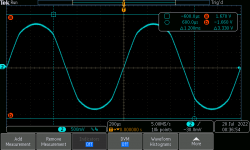 tek00009.png12.1 KB · Views: 124
tek00009.png12.1 KB · Views: 124 -
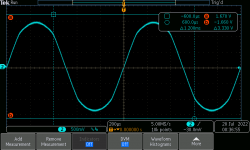 tek00010.png29 KB · Views: 121
tek00010.png29 KB · Views: 121 -
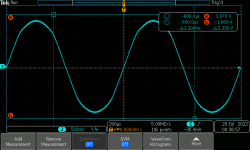 tek00011.png29.3 KB · Views: 118
tek00011.png29.3 KB · Views: 118 -
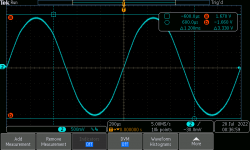 tek00012.png29.8 KB · Views: 116
tek00012.png29.8 KB · Views: 116 -
 tek00013.png29.8 KB · Views: 122
tek00013.png29.8 KB · Views: 122 -
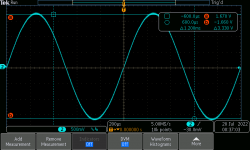 tek00014.png12.8 KB · Views: 121
tek00014.png12.8 KB · Views: 121
Last edited:
I'm bothered every time I see a THD plot (emphasis on T especially), and especially in this thread. The main idea behind a "soft clipper" is to reduce the HIGHER HARMONICS generated by the hard clipping that happens when a common high-feedback circuit hits its signal voltage limits. A THD response curve does not distinguish harminics, all it shows is what we already know, that (total) distortion starts happening at lower signal level, and on a lower part of the waveform, but due to no sudden changes in the waveform, higher harmonics are generated at a much lower level and thus "soft clipping" doesn't sound nearly as bad. (I could say "better" but I just saw an argument in another thread over "how can increasing distortion make something sound better," but maybe I should pretend I didn't read that).
This gets to the rant I've made about THD several times before. The GedLee Metric is an attempt at something better than THD, but I still think two values are needed, the low-harmonic distortion, and the high-harmonic distortion. I don't know what harmonic number the measurements should cross over at, probably between third and sixth. Regardless, as far as I know no one else has looked into this, and probably no one else will, so it's up to me. Maybe I'll actually research this, maybe try to submit a write-up to JAES or something, or at least put it on a website.
THD isn't just a barely usable metric from over half a century ago, its existence actively causes misunderstanding. How many times have we read "but a speaker makes so much distortion, how can we possibly hear 1/100th of that distortion from an amp through a speaker?" Because THD is a misleading measurement. Speakers and amplifiers make different kinds of easily distinguishable distortion, so that having distortion as single number is misleading.
This gets to the rant I've made about THD several times before. The GedLee Metric is an attempt at something better than THD, but I still think two values are needed, the low-harmonic distortion, and the high-harmonic distortion. I don't know what harmonic number the measurements should cross over at, probably between third and sixth. Regardless, as far as I know no one else has looked into this, and probably no one else will, so it's up to me. Maybe I'll actually research this, maybe try to submit a write-up to JAES or something, or at least put it on a website.
THD isn't just a barely usable metric from over half a century ago, its existence actively causes misunderstanding. How many times have we read "but a speaker makes so much distortion, how can we possibly hear 1/100th of that distortion from an amp through a speaker?" Because THD is a misleading measurement. Speakers and amplifiers make different kinds of easily distinguishable distortion, so that having distortion as single number is misleading.
By all means, go ahead! I can't believe that any half-decent amplifier produces more high-order distortion than a loudspeaker, or even produces so much distortion that it becomes audible, but it would be nice to see that confirmed or denied.
Earl Geddes has published on distortion perception. He explains why amplifier distortion and speaker distortion are different and how THD fails to differentiate the two in the following paper: http://www.gedlee.com/Papers/Distortion_AES_I.pdf
Beyond what the paper says, we measure distortion with steady-state test signals, then assume that the system under test is sufficiently linear and time-invariant to extrapolate that transient distortion effects should be consistent with steady state measurements. How do you know that assumption is correct? Do we have transient distortion measurements to justify the assumption?
EDIT: More interesting commentary from Geddes: http://www.gedlee.com/Papers/Comments on howard.pdf
Beyond what the paper says, we measure distortion with steady-state test signals, then assume that the system under test is sufficiently linear and time-invariant to extrapolate that transient distortion effects should be consistent with steady state measurements. How do you know that assumption is correct? Do we have transient distortion measurements to justify the assumption?
EDIT: More interesting commentary from Geddes: http://www.gedlee.com/Papers/Comments on howard.pdf
Last edited:
A good example of blind faith is mentioning Gedlee Metric as an alternative to current metrics. No usable tools or results anywhere. But still lots of faith in that it must be better.
Have you been following this thread, and the desire for soft clipping? Perhaps a "half-decent amplifier" should have infinite power so it never clips.By all means, go ahead! I can't believe that any half-decent amplifier produces more high-order distortion than a loudspeaker, or even produces so much distortion that it becomes audible, but it would be nice to see that confirmed or denied.
the idea behind my two-value distortion metric is more general than testing amp distortion vs. speaker distortion, it's about what type of distortion is more audible than another type, even though the THD may be the same.
And yes, of course I've read that and related threads in this forum.Earl Geddes has published on distortion perception. He explains why amplifier distortion and speaker distortion are different and how THD fails to differentiate the two in the following paper: http://www.gedlee.com/Papers/Distortion_AES_I.pdf
Yes, but this is getting into more subtle things (such as a large transient heating a voice coil giving it higher resistance and less sensitivity to immediately following signals), when everyone is still using THD as a standard metric though most people know it's gross, as in objectionable as well as very inexact.Beyond what the paper says, we measure distortion with steady-state test signals, then assume that the system under test is sufficiently linear and time-invariant to extrapolate that transient distortion effects should be consistent with steady state measurements. How do you know that assumption is correct? Do we have transient distortion measurements to justify the assumption?
This thesis provides enough tools and data to apply in a design: https://next-tube.com/articles/Cheever/cheever.pdfA good example of blind faith is mentioning Gedlee Metric as an alternative to current metrics. No usable tools or results anywhere. But still lots of faith in that it must be better.
One of the conclusions could be that using an amp needing a soft clipper already is a bad idea.
Clipping isn't all bad in audio. 11 years back I bought a CD that has MASSIVE amounts ofHave you been following this thread, and the desire for soft clipping? Perhaps a "half-decent amplifier" should have infinite power so it never clips.
the idea behind my two-value distortion metric is more general than testing amp distortion vs. speaker distortion, it's about what type of distortion is more audible than another type, even though the THD may be the same.
clipping - presumably in an effort to be LOUD. It sounds surprisingly good. In post 84 by
me, the 2nd pic is my soft clipper in "hard" clip. If you look at the datasheet for the AD8036
you'll find about 3mV of transition in and out of clip. This is very similar to the CD clipping.
Notice there is no 'hangover' which is common in solid state amps coming out of clipping.
I call those discontinuities. Crossover distortion, rubbing voice coils cause discontinuities
which we find very objectionable.
Historically THD in its simplest form is start with a 'perfect' sinewave, filter out the fundamental
and see what's left which of course includes noise. If you convert noise to percentage you'll
notice that good electronics rarely vary as much as 2:1 (6dB) between the stated distortion
and the noise floor. IM distortion is much more telling than THD but is still short of the goal.
I worked commercial video for 45 years and in analog video there is 'differential gain' which in
an exact analogy to audio IM. Mix a low amplitude high frequency to a high amplitude low
frequency, filter out the low and look at what's left. In video that is a constant amplitude subcarrier
on a linearity ramp. BUT there is another video measurement with the same modulated ramp that
measures PHASE shift of the subcarrier called - you guessed it - differential PHASE. There is no
(that I'm aware of) analogy in audio test signals. Should there be?
G²
Attachments
Have you been following this thread, and the desire for soft clipping?
I was under the impression that your remark about amplifiers distorting 100 times less than loudspeakers was related to amplifiers that are not driven into clipping.
I'm quite sure a clipping amplifier can distort audibly and worse than a loudspeaker, but I doubt that its THD will then be 100 times less than that of a typical loudspeaker.
Perhaps a "half-decent amplifier" should have infinite power so it never clips.
There is no need for that, but it should have a clipping LED that turns on for a second when the amplifier clips momentarily, so you know that you have to turn down the volume.
I built a two times 20 W into 8 ohm amplifier with such a LED in 1994. The LED never turns on in normal domestic use.
the idea behind my two-value distortion metric is more general than testing amp distortion vs. speaker distortion, it's about what type of distortion is more audible than another type, even though the THD may be the same.
That was clear from your previous post.
Assuming an amplifier with quite bad crossover distortion. See also figure 1B in http://www.gedlee.com/Papers/Distortion_AES_II.pdf Abrupt low-level non-linearities do occur whenever you round digital signals without dither, by the way.Earl Geddes has published on distortion perception. He explains why amplifier distortion and speaker distortion are different and how THD fails to differentiate the two in the following paper: http://www.gedlee.com/Papers/Distortion_AES_I.pdf
That thesis has been discussed here several times (just do a search). There are some that don't agree with you.This thesis provides enough tools and data to apply in a design: https://next-tube.com/articles/Cheever/cheever.pdf
One of the conclusions could be that using an amp needing a soft clipper already is a bad idea.
Going back to Bob's Klever Klipper. It's behaviour, how hard/fast it clips is a fuction of the signal levels it is designed for.
The reason is that the clipping behaiour depends on the ratio of the signal level to the diode threshold.
Setting it up for an onset of soft clipping with a 1V signal for instance makes it start to clip relatively early but softer.
Setting it up for say 5V signal makes the onset relatively late butclip harder.
So by selecting the signal level you can make the onset late, so there is less distortion before clipping, but then it will clip harder.
Pick your poison.
KK-1-5 is a klever klipper set up to clip at 1V with 1V signal and set up for 5V and with 5V signal. You see that the 5V signal shows no clipping.
KK-1.5-7.7 is the same setup but now with 1.5V and 7.5V signal (50% over). Both signals show clipping but now the 7.5V clips harder.
Jan
The reason is that the clipping behaiour depends on the ratio of the signal level to the diode threshold.
Setting it up for an onset of soft clipping with a 1V signal for instance makes it start to clip relatively early but softer.
Setting it up for say 5V signal makes the onset relatively late butclip harder.
So by selecting the signal level you can make the onset late, so there is less distortion before clipping, but then it will clip harder.
Pick your poison.
KK-1-5 is a klever klipper set up to clip at 1V with 1V signal and set up for 5V and with 5V signal. You see that the 5V signal shows no clipping.
KK-1.5-7.7 is the same setup but now with 1.5V and 7.5V signal (50% over). Both signals show clipping but now the 7.5V clips harder.
Jan
Attachments
No surprise: all such tests with test persons are flawed. Response to distortion measurement should be done with sensors (neural / biochemical activity) at the subliminal level and every test person's response should be calibrated first.That thesis has been discussed here several times (just do a search). There are some that don't agree with you.
You should read some of the earlier discussion here on Cheever's thesis. The problem is not using test persons.No surprise: all such tests with test persons are flawed.
Humans have a history as prey animals. Sense of hearing adapted to that hence the need to estimate distance from sounds. As a function of distance, high frequencies are more attenuated than low frequencies and (from a natural source) the amplitude of each following harmonic is supposed to descend. Similar issue with percussive sounds.And I thought I was reductionistic.
- Home
- Amplifiers
- Solid State
- Wanted: distortion free soft clipping circuit
